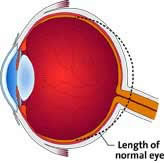Farsightedness |
Also known as hyperopia, farsightedness is caused by a cornea that is flatter than a normal eye. When light enters the eye it focuses behind the retina instead of directly on it. As a result, farsighted people usually have trouble seeing up close, but may also have difficulty seeing far away as well.
As the eye gradually loses the ability to accommodate, and thus its elasticity, blurred vision often becomes more apparent.
Treatment
The treatment for hyperopia depends on several factors such as the patient's age, activities, and occupation. Young patients may or may not require glasses or contact lenses, depending on their ability to compensate for their farsightedness with accommodation. Glasses or contact lenses are usually required for older patients.
Refractive surgery is also an option for those who wish to see clearly without glasses. LASIK, LTK, clear lens extraction and intraocular contact lenses are procedures that can correct hyperopia.
Your eye doctor will be able to determine if you have hyperopia through a complete eye examination and recommend the right treatment for you.
|


|
|
|
|
|

